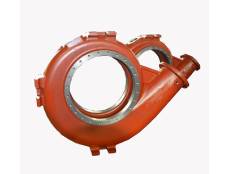+86 311 85258258
+86 311 85258258
Jun. 17, 2020
Ductile iron is an important cast metal material developed in the past 40 years. Due to the small concentration of stress caused by spherical graphite, the cutting effect on the substrate is also small, so the tensile strength, plasticity, and toughness of ductile iron are higher than other cast irons. Compared with the steel of the corresponding structure, the plasticity is lower than that of steel, and the fatigue strength is close to that of ordinary medium carbon steel. The yield strength ratio can reach 0 7 ~ 0 8, almost twice that of ordinary carbon steel, and the cost is lower than steel, so its application More and more widely.
Of course, ductile iron is not perfect. In addition to general casting defects, it will also produce some unique defects, such as shrinkage, slag inclusions, subcutaneous pores, poor spheroidization and recession. These defects affect the performance of castings and increase the scrap rate of castings. In order to prevent the occurrence of these defects, it is necessary to analyze them and perform precision casting, sum up various influencing factors and put forward preventive measures to effectively reduce the occurrence of defects and improve the mechanical properties and production benefits of castings. OEM Metal Parts manufacturer will discuss the main common defects of ductile iron parts: shrinkage, shrinkage, slag inclusion, subcutaneous pores, graphite floating, poor spheroidization, and spheroidization decline.

Ductile Iron Pump Volute
1Shrinkage shrinkage
1.1 Influencing factors
(1) Carbon equivalent: Increasing the amount of carbon increases graphitization expansion and reduces shrinkage and shrinkage. In addition, increasing the carbon equivalent can also increase the fluidity of the ductile iron, which is beneficial for feeding. The empirical formula for producing high-quality castings is C%+1/7Si%>39%. However, when increasing the carbon equivalent, other defects such as graphite floating should not be caused in the casting.
(2) Phosphorus: The phosphorus content in the molten iron is relatively high, which expands the solidification range. At the same time, the low melting point phosphorus eutectic cannot be replenished during the final solidification, and the casting shell becomes weak, so there are increased shrinkage and shrinkage. The resulting tendency. Generally, the phosphorus content of the plant should be less than 0 08%.
(3) Rare earth and magnesium: Excessive amounts of rare earth will deteriorate the shape of graphite and reduce the spheroidization rate, so the content of the rare earth should not be too high. Magnesium is an element that strongly stabilizes carbides and hinders graphitization. It can be seen that the amount of residual magnesium and the amount of residual rare-earth will increase the white tendency of ductile iron and reduce the expansion of graphite, so when their content is higher, it will also increase the tendency of shrinkage and shrinkage.
(4) Wall thickness: When a hard shell is formed on the surface of the casting, the higher the temperature of the internal molten metal, the greater the liquid shrinkage. The volume of shrinkage and shrinkage not only increases in absolute value but also increases in relative value. In addition, if the wall thickness changes too abruptly, the isolated thick section cannot be compensated, increasing the tendency of shrinkage and shrinkage.
(5) Temperature: The pouring temperature is high, which is helpful for shrinkage, but too high will increase the amount of liquid shrinkage, which is not conducive to eliminating shrinkage and shrinkage. Therefore, the pouring temperature should be reasonably selected according to the specific situation, generally 1300 ~ 1350 ℃.
(6) The compactness of the sand mold: If the compactness of the sand mold is too low or uneven, the cavity expansion phenomenon will occur under the action of the metal static pressure or expansion force after casting, so that the original metal is not enough to shrink. Cause shrinkage and shrinkage of castings.
(7) Pouring riser and cold iron: If the pouring system, riser and cold iron are set improperly, the sequential solidification of the molten metal cannot be guaranteed; in addition, the number and size of risers and whether they are connected to the casting will affect the feeder's filling Shrink effect.
1.2 Preventive measures
(1) Control the composition of molten iron: maintain a high carbon equivalent (>39%); minimize the phosphorus content (<0 08%); reduce the amount of residual magnesium (<0 07%); use rare earth magnesium alloy for treatment, The residual amount of rare earth oxide is controlled at 0 02% ~ 0 04%.
(2) The process design should ensure that the castings can continuously replenish the high-temperature metal liquid from the riser during solidification, the size and number of the riser should be appropriate, and strive to achieve sequential solidification.
(3) If necessary, use cold iron and subsidies to change the temperature distribution of the casting to facilitate sequential solidification.
(4) The pouring temperature should be 1300~1350℃, and the pouring time of a package of molten iron should not exceed 25min to avoid spheroidization.
(5) Improve the compactness of the sand mold, generally not less than 90; hit the sand uniformly, the water content should not be too high, to ensure that the mold has sufficient rigidity.
Our company provides Ductile iron Pump Volute, if you are interested in our products, please feel free to contact us.